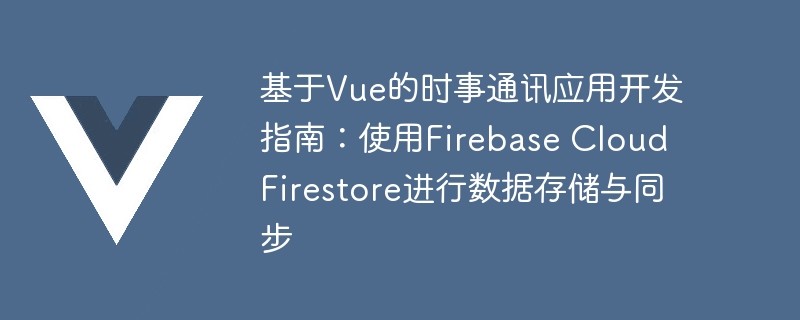Home >Web Front-end >Vue.js >Vue-based newsletter application development guide: using Firebase Cloud Firestore for data storage and synchronization
Vue-based newsletter application development guide: using Firebase Cloud Firestore for data storage and synchronization
- WBOYWBOYWBOYWBOYWBOYWBOYWBOYWBOYWBOYWBOYWBOYWBOYWBOriginal
- 2023-09-13 12:28:521130browse

Vue-based newsletter application development guide: using Firebase Cloud Firestore for data storage and synchronization
Introduction:
With the popularity of mobile applications, people are interested in Current news is also in increasing demand. Building a real-time newsletter application became the focus of developers. This article will introduce how to use Vue and Firebase Cloud Firestore to build a simple yet powerful newsletter application.
- Introduction to Firebase Cloud Firestore
Firebase Cloud Firestore is a cloud storage service provided by Google. It is a flexible and scalable NoSQL database that can be used to store and synchronize data. It supports real-time updates and provides powerful query capabilities. In this tutorial, we will use Firestore as our data storage and synchronization solution. - Preparation
Before starting, we need to prepare the following environment: - Install Node.js and npm (https://nodejs.org/)
- Create A Firebase project and get the credentials (https://firebase.google.com/)
-
Create Vue project
First, we need to create a Vue project. Run the following command from the command line:npm install -g @vue/cli vue create news-app cd news-app npm run serve
This will create a project called "news-app" and run the development server.
-
Configuring Firebase
Open the Firebase console (https://console.firebase.google.com/) and create a new project. Then, click "Project Settings", select "Add App", and select Web App. After registering your app, paste the provided configuration code into the src/main.js file. Your main.js file should look like this:import Vue from 'vue' import App from './App.vue' import firebase from 'firebase' const firebaseConfig = { // 将你的Firebase配置信息在这里填入 } firebase.initializeApp(firebaseConfig) Vue.config.productionTip = false new Vue({ render: h => h(App), }).$mount('#app') -
Create the News List Component
We will first create a Vue component for displaying the News List. Create a file named NewsList.vue in the src/components directory and add the following code:<template> <div> <h1>时事新闻</h1> <ul> <li v-for="news in newsList" :key="news.id"> {{ news.title }} </li> </ul> </div> </template> <script> import firebase from 'firebase' export default { data() { return { newsList: [] } }, mounted() { const db = firebase.firestore() const newsRef = db.collection('news') newsRef.onSnapshot(querySnapshot => { let newsList = [] querySnapshot.forEach(doc => { newsList.push({ id: doc.id, title: doc.data().title }) }) this.newsList = newsList }) } } </script> -
Create News Creation Component
Next, we will create a Vue component that creates news. Create a file named CreateNews.vue in the src/components directory and add the following code:<template> <div> <h1>创建新闻</h1> <form @submit.prevent="createNews"> <input type="text" v-model="title" placeholder="标题" required> <input type="text" v-model="content" placeholder="内容" required> <button type="submit">创建</button> </form> </div> </template> <script> import firebase from 'firebase' export default { data() { return { title: '', content: '' } }, methods: { createNews() { const db = firebase.firestore() db.collection('news').add({ title: this.title, content: this.content }) .then(() => { this.title = '' this.content = '' }) .catch(error => console.error(error)) } } } </script> -
Integrated components
Finally, we need to integrate the NewsList and CreateNews components into App.vue file. Modify the App.vue file as follows:<template> <div> <NewsList/> <CreateNews/> </div> </template> <script> import NewsList from './components/NewsList.vue' import CreateNews from './components/CreateNews.vue' export default { components: { NewsList, CreateNews } } </script>
So far, we have completed a newsletter application based on Vue and Firebase Cloud Firestore. You can add, edit and delete news in Firebase, and it will be displayed in the application interface in real time.
Conclusion:
This article describes how to build a newsletter application using Vue and Firebase Cloud Firestore. By integrating Firebase Cloud Firestore, we can quickly implement real-time data storage and synchronization functions. I hope this article will be helpful to your Vue application development!
The above is the detailed content of Vue-based newsletter application development guide: using Firebase Cloud Firestore for data storage and synchronization. For more information, please follow other related articles on the PHP Chinese website!

